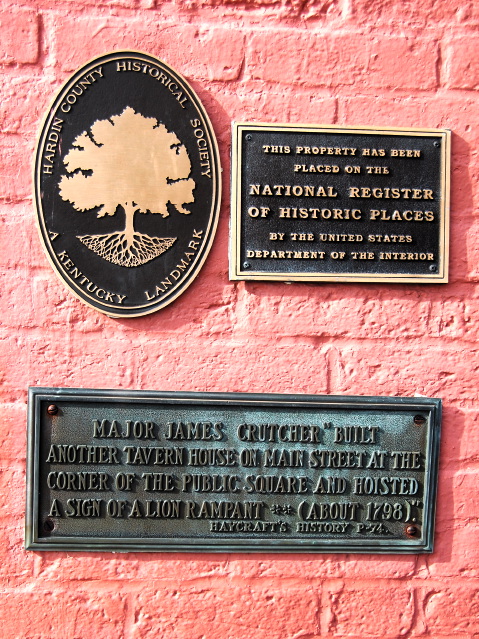HARDIN
COUNTY KENTUCKY |
||||||||
| Research Data | County Links | Other Links | Mailing Lists | Lookups | Queries | Project Info | ||
HARDIN COUNTY, KENTUCKY was officially formed in 1793 from territory bounded on the south and west from the Green River close to its headwaters, near Campbellsville, to where it joins the Ohio River near Henderson, on the north following the Ohio River (to West Point), and on the east along the massive Muldraugh escarpment. In 1793 it was the fourth largest county in Kentucky. Prior to 1793, the Hardin County land area was located entirely in Nelson County (1784) and Jefferson County (1780). This vast Hardin County area was first expored in 1766 by a hunting expedition led by Col. John Smith, and later expeditions during the 1770's.The original Hardin County land area eventually provided a substantial portion of twelve Kentucky counties: Breckinridge (1799), Butler (1810), Daviess (1815), Edmonson (1825), Grayson (1810), Hancock (1829), Hardin (1793), Hart (1819), Larue (1843), McLean (1854), Meade (1823), and Ohio (1798).Several Pioneer Settlements were raised in this early Hardin County area, including, Forts of Col. Samuel Haycraft, Capt. Thomas Helm, Col. Andrew Hyne, and Philip Phillips (Larue County), all in 1780, and Barnett's Station (Ohio County), Shaw's Station (Grayson County), and Yellowbanks (Daviess County) in the 1790's. Severn's Valley Baptist Church, organized in 1781, near Hynes Station, is the oldest continuing Baptist congregation west of Allegheny Mountains.The county was named for John Hardin, 1753–1792 (pdf), a Continental Army officer during the American Revolutionary War who was wounded at Saratoga and was killed by Shawnee in Ohio while delivering a message of peace from Secretary of War Henry Knox and President George Washington.The county seat of Elizabethtown was formally incorporated in July 1797, and named for Elizabeth, wife of Col. Andrew Hynes and currently ranks 14th in Kentucky population. Other incorporated towns include Radcliff, Sonora, Upton, Vine Grove, and West Point, with notable communities of Blue Ball, Big Spring, Cecilia, Colesburg, Eastview, Flint Hill, Glendale, Hardin Springs, Howe Valley, Nolin, Rineyville, Star Mills, St. John, Stephensburg, Vertrees, and White Mills. The Army Post and Bullion Depository at Fort Knox lies largely within Hardin County.Abraham Lincoln , 1809-1865, the 16th President of the United States, was born in Hardin County, KY, on Thomas Lincoln's Sinking Spring Farm which became part of Larue County in 1843. Confederate General Ben Hardin Helm, Lincoln's brother-in-law, was the son of Kentucky Governor John L. Helm, also a Hardin County native. Gen. George Custer lived in Hardin County from 1871 to 1873 as part of a military effort to "suppress Ku Klux Klan and carpetbaggers, to break up illicit distilleries."Genealogical Resources in Hardin County include archives of the Brown-Pusey House (a Georgian mansion built in 1825 by John Y. Hill, that is on the National Historic Register) and the Ancestral Trails Historical Society, located inside the Hardin County History Museum. Nearly all of the original records of Hardin County remain intact in the Office of the County Clerk, and scanned images of many documents, including Marriages, Wills, and Deeds, may be conveniently accessed online.Hardin County is located on a Mississippian plateau designated as the Pennyrile region of Kentucky, that boundries the northern bank of the Green River throughout the West-Central section of the state, with an area of 628 square miles. As shown in the map below, Hardin County is bordered by Meade, Breckinridge, Grayson, Hart, Larue, Nelson, and Bullitt counties. The elevation in the county ranges from 383 to 1017 feet above sea level.
|
|||
 |
|

County Coordinator: William
R. Vincent 
Assistant County Coordinator: John
G. West 
Created by Bill Vincent, © 2009

 |
Hardin
County Map of 1895 |
 |